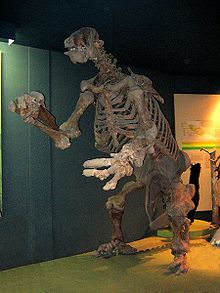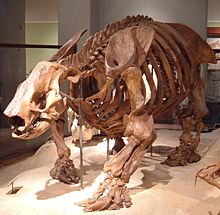- Ground sloth
-
Ground sloths
Temporal range: Oligocene - Holocene
Harlan's Ground Sloth (Paramylodon harlani), a mylodontid Scientific classification Kingdom: Animalia Phylum: Chordata Class: Mammalia Subclass: Theria Infraclass: Eutheria Superorder: Xenarthra Order: Pilosa Suborder: Folivora (partim) Families - Bradypodidae
- Megalonychidae
- †Megatheriidae
- †Nothrotheriidae
- †Mylodontidae
- †Orophodontidae
Ground sloths are a diverse group of extinct sloths, in the mammalian superorder Xenarthra. Their most recent survivors lived in the Antilles, where it has been proposed they may have survived until 1550 CE;[1] however, the youngest AMS radiocarbon date reported is 4190 BP, calibrated to c. 4700 BP for Megalocnus of Cuba.[2] They had been extinct on the mainland of North and South America for 10,000 years or more.[3] The term "ground sloth" is used as a reference for all extinct sloths because of the large size of the earliest forms discovered, as opposed to the extant "tree sloths." However, this is a historical convention and does not imply that all extinct sloths were strictly terrestrial in nature.[4]
The bulk of ground sloth evolution took place during the mid to late Tertiary of South America while the continent was isolated. At their earliest appearance in the fossil record, the ground sloths are already distinct at the family level. The presence of intervening islands between the American continents in the Miocene allowed a dispersal of forms into North America. A number of mid- to small-sized forms are believed to have previously dispersed to the Antilles islands either by making short swims or using land bridges that are now submerged. Ground sloths were a hardy group as evidenced by their diverse numbers and dispersals into remote areas given the finding of their remains in Patagonia (Cueva del Milodón)[5] and parts of Alaska.
Sloths, and xenarthrans as a whole, represent one of the more successful South American groups during the Great American Biotic Interchange. During the interchange, many more taxa moved from North America into South America than in the other direction. At least five genera of ground sloths have been identified in North American fossils; these are examples of successful immigration to the north.
Contents
Families
Paleontologists divide more than 80 genera of ground sloths in multiple families.[6]
Megalonychidae
Reconstruction based on Megalonyx jeffersonii, Iowa Museum of Natural History, University of Iowa.
The megalonychid ground sloths first appeared in the early Oligocene, about 35 million years ago, in southern Argentina (Patagonia). Megalonychids first reached North America by island-hopping, prior to the formation of the Isthmus of Panama. Some lineages of megalonychids increased in size as time progressed. The first species of these were small and may have been partly tree-dwelling, whereas the Pliocene (about 5 to 2 million years ago) species were already approximately half the size of the huge Late Pleistocene Megalonyx jeffersonii from the last ice age. Some West Indian island species were as small as a large cat; their dwarf condition typified both tropical adaptation and their restricted island environment. This small size also enabled them a degree of aboreality.[4]
Megalonyx, which means "giant claw" is a widespread North American genus, lived past the close of the last (Wisconsin) glaciation, when so many large mammals died out. Remains have been found as far north as Alaska[7] and the Yukon.[8][9] Ongoing excavations at Tarkio Valley in southwest Iowa may reveal something of the familial life of Megalonyx. An adult was found in direct association with two juveniles of different ages, suggesting that adults cared for young of different generations.[10][11]
The earliest known North American megalonychid, Pliometanastes protistus, lived in Florida and the southern U.S. about 9 million years ago, and is believed to have been the predecessor of Megalonyx. Several species of Megalonyx have been named; in fact it has been stated that "nearly every good specimen has been described as a different species".[8] A broader perspective on the group, accounting for age, sex, individual and geographic differences, indicates that only three species are valid (M. leptostomus, M. wheatleyi, and M. jeffersonii) in the late Pliocene and Pleistocene of North America.[12] Although work by McDonald lists five species. Jefferson's ground sloth has a special place in modern paleontology, for Thomas Jefferson's letter on Megalonyx, read before the American Philosophical Society of Philadelphia, in August 1796, marked the beginning of vertebrate paleontology in North America.[8] When Lewis and Clark set out, Jefferson instructed Meriwether Lewis to keep an eye out for ground sloths. He was hoping they would find some living in the Western range. Megalonyx jeffersonii was appropriately named after Thomas Jefferson.[8]
Megatheriidae
The megatheriid ground sloths are relatives of the megalonychids; these two families, along with the family Nothrotheriidae (see below), form the infraorder Megatheria. Megatheriids appeared later in the Oligocene, some 30 million years ago, also in South America. The group includes the heavily-built Megatherium (given its name 'great beast' by Georges Cuvier[13]) and Eremotherium. The skeletal structure of these ground sloths indicates that the animals were massive. Their thick bones and even thicker joints (especially those on the hind legs) gave their appendages tremendous power that, combined with their size and fearsome claws, provided a formidable defense against predators.
The earliest megatheriid in North America was Eremotherium eomigrans which arrived 2.2 million years ago, after crossing the recently formed Panamanian land bridge. With more than five tons in weight, 6 meters in length, and able to reach as high as 17 feet (5.2 m), it was taller than an African Bush Elephant bull. Unlike relatives, this species retained a plesiomorphic extra claw. While other species of Eremotherium had four fingers with only two or three claws, E. eomigrans had five fingers, four of them with claws up to nearly a foot long.[14]
Nothrotheriidae
Recently recognized, members of Nothrotheriidae are often associated with those of the Megatheriidae, and together the two form the superfamily Megatheroidea. The most prominent members of the group are the South American genus Thalassocnus, known for being aquatic, and Nothrotheriops from North America.
The last ground sloths in North America belonging to Nothrotheriops died so recently that their petrified dung (coprolites) has remained undisturbed in some caves, as if it were just recently deposited. One of the skeletons, found in a lava tube (cave) at Aden Crater, adjacent to Kilbourne Hole, New Mexico, still had skin and hair preserved, and is now at the Yale Peabody Museum. The American Museum of Natural History in New York City has a sample of dung with a note attached to it that reads "deposited by Theodore Roosevelt". The largest samples of Nothrotheriops dung can be found in the collections of the Smithsonian Museum.
Mylodontidae
The mylodontid ground sloths together with their relatives the scelidotheriids and the orophodontids form the Mylodonta, the second radiation of ground sloths. The discovery of their fossils in caverns associated with human occupation lead some early researchers to theorize that the early humans built corrals when they could procure a young ground sloth, to raise the animal to butchering size.[15] However, radiocarbon dates do not support simultaneous occupation of the site by humans and sloths.[16] Subfossil remains like coproliths, fur and skin have been discovered in some quantities.
Orophodontidae
The orophodontid ground sloths constitute a rather small but quite distinct group. They are classified as a distinct mylodontan superfamily Orophodontoidea, the sister taxon to the Mylodontoidea.
In cryptozoology
Cryptozoologists often identify the mapinguari, a mythical forest creature of the upper Amazon basin, with a surviving tropical ground sloth or folk memory of these animals.
Footnotes
- ^ R.M. Nowak (1999)
- ^ MacPhee, R. D. E.; Iturralde-Vinent, M. A.; Vázquez, O. J. (June, 2007). "Prehistoric Sloth Extinctions in Cuba: Implications of a New "Last" Appearance Date". Caribbean Journal of Science (College of Arts and Sciences, University of Puerto Rico) 43 (1): 94–98. http://caribjsci.org/June07/43_94-98.pdf. Retrieved 2009-05-11.
- ^ Fiedal, Stuart (2009). "Sudden Deaths: The Chronology of Terminal Pleistocene Megafaunal Extinction". In Haynes, Gary. American Megafaunal Extinctions at the End of the Pleistocene. Springer. pp. 21–37. doi:10.1007/978-1-4020-8793-6_2. ISBN 978-1-4020-8792-9. http://www.springerlink.com/content/l225628681672725/?p=5af1eb7387d443a2b514b284c646efa7&pi=1
- ^ a b J.L. White (1993)
- ^ C.M. Hogan (2008)
- ^ Modified from McKenna & Bell (1997)
- ^ Stock, C. (1942-05-29). "A ground sloth in Alaska". Science (AAAS) 95 (2474): 552–553. doi:10.1126/science.95.2474.552. PMID 17790868.
- ^ a b c d Harrington (1993)
- ^ McDonald, H. G.; Harington, C. R.; De Iuliis, G. (September 2000). "The Ground Sloth Megalonyx from Pleistocene Deposits of the Old Crow Basin, Yukon, Canada" (PDF). Arctic (Calgary, Alberta: The Arctic Institute of North America) 53 (3): 213–220. http://pubs.aina.ucalgary.ca/arctic/Arctic53-3-213.pdf. Retrieved 2008-08-16.
- ^ Semken and Brenzel, http://slothcentral.com/?page_id=2
- ^ Semken; Brenzel (2007). "One Sloth Becomes Three". Newsletter of the Iowa Archeological Society 57: 1.
- ^ Kurtén & Anderson, 1980, p. 136.
- ^ G. Cuvier (1796)
- ^ De Iuliis and Cartelle (1999)
- ^ A.S. Woodward (1900)
- ^ Naish, Darren (28 Nov 2005). "Fossils explained 51: Sloths". Geology Today (Geologists' Association, Geological Society of London and Blackwell Publishing) 21 (6): 232–238. doi:10.1111/j.1365-2451.2005.00538.x. http://www3.interscience.wiley.com/journal/118652140/abstract. Retrieved 2009-01-29.
References
- Cuvier, G. (1796): Notice sur le squellette d'une très grande espèce de quadrupède inconnue jusqu'à présent, trouvé au Paraquay, et déposé au cabinet d'histoire naturelle de Madrid. Magasin encyopédique, ou Journal des Sciences, des Lettres et des Arts (1): 303-310; (2): 227-228.
- De Iuliis, G. & Cartelle, C. (1999): A new giant megatheriine ground sloth (Mammalia: Xenarthra: Megatheriidae) from the late Blancan to early Irvingtonian of Florida. Zool. J. Linn. Soc. 127(4): 495-515.
- Harrington, C.R. (1993): Yukon Beringia Interpretive Center - Jefferson's Ground Sloth. Retrieved 2008-JAN-24.
- Hogan, C.M. (2008): Cueva del Milodon, Megalithic Portal. Retrieved 2008-APR-13
- Kurtén, Björn and Anderson, Elaine (1980): Pleistocene Mammals of North America. Columbia University Press, New York. ISBN 0-231-03733-3
- McKenna, Malcolm C. & Bell, Susan K. (1997): Classification of Mammals Above the Species Level. Columbia University Press, New York. ISBN 0-231-11013-8
- Nowak, R.M. (1999): Walker's Mammals of the World (Vol. 2). Johns Hopkins University Press, London.
- White, J.L. (1993): Indicators of locomotor habits in Xenarthrans: Evidence for locomotor heterogeneity among fossil sloths. Journal of Vertebrate Paleontology, 13(2): 230-242.
- White, J.L. & MacPhee, R.D.E. (2001): The sloths of the West Indies: a systematic and phylogenetic review. In: Woods, C.A. & Sergile, F.E. (eds.): Biogeography of the West Indies: Patterns and Perspectives: 201-235.
- Woodward, A.S. (1900): On some remains of Grypotherium (Neomylodon) listai and associated mammals from a cavern near Consuelo Cove, Last Hope Inlet. Proceedings of the Zoological Society of London, 1900(5): 64-79.
External links
- Sloth World: An Online Sloth Bibliography.
- Picture and information about a ground sloth skeleton on display at the University of Georgia's Science Library.
- Academy of Natural Sciences ground sloth page.
- Illinois State Museum ground sloth page.
- Ground sloths at La Brea.
- Eremotherium in Florida.
- Have some ground sloths survived in Argentina?
- Ground sloths in general.
- Western Center for Archaeology and Paleontology Hemet, CA
Categories:- Prehistoric sloths
- Oligocene mammals
- Miocene mammals
- Pliocene mammals
- Pleistocene mammals
- Prehistoric mammals of South America
- Megafauna of South America
- Extinct cave organisms
Wikimedia Foundation. 2010.



